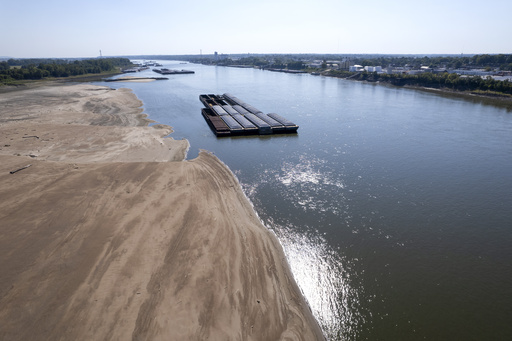The water level of the Mississippi River has dropped significantly for the third consecutive year, causing challenges for barge companies and impacting farm profits. Despite recent flooding in some areas just two months ago, the river level has steadily decreased, particularly affecting regions south of St. Louis. This decline echoes similar low-water situations experienced in 2022 and 2023 around the same period.
Barge companies have been compelled to impose restrictions on the amount of cargo they transport, such as soybeans and grain, to prevent barges from potentially getting stranded. This limitation results in reduced profits for farmers. Notably, approximately 60% of U.S. grain exports are typically transported via barges along the Mississippi to New Orleans for storage and international shipment, as it is a cost-effective means of moving crops.
Due to the cargo limitations, the latest report from the U.S. Department of Agriculture revealed a 17% decrease in the transportation of grain via barges for the week ending Aug. 31. Meanwhile, freight rates from St. Louis and Memphis have surged compared to previous years, with St. Louis rates up 8% from last year and 57% from the three-year average, and Memphis rates up 10% from last year and 63% from the three-year average.
While consumers may not immediately feel the impact, farmers are likely to bear the brunt of the situation. The cost increase in transportation could lead to a dilemma for industries on whether to pass on the additional costs to customers through higher prices. However, farmers, in this case, may not have that flexibility as their goods are sold internationally. Should American soybean prices rise, foreign buyers can seek alternatives from other countries.
The Mississippi River experienced major flooding in states like Iowa, Illinois, and Wisconsin back in July, requiring some individuals to navigate by boat. The excessive water from the upper Mississippi River was counteracted by drought in states along the Ohio River, aggravating over the summer and worsening through August. The growing drought has led to record-low levels in parts of the Mississippi River, further exacerbating the current water level situation.
Officials like Michael Clay from the Corps of Engineers’ Memphis office mentioned that the drought conditions are escalating, necessitating strategic dredging operations to address emerging concerns. To bring some relief, Hurricane Francine is anticipated to bring substantial rainfall, including up to four inches in Memphis and other areas along the lower Mississippi River in the upcoming days.
